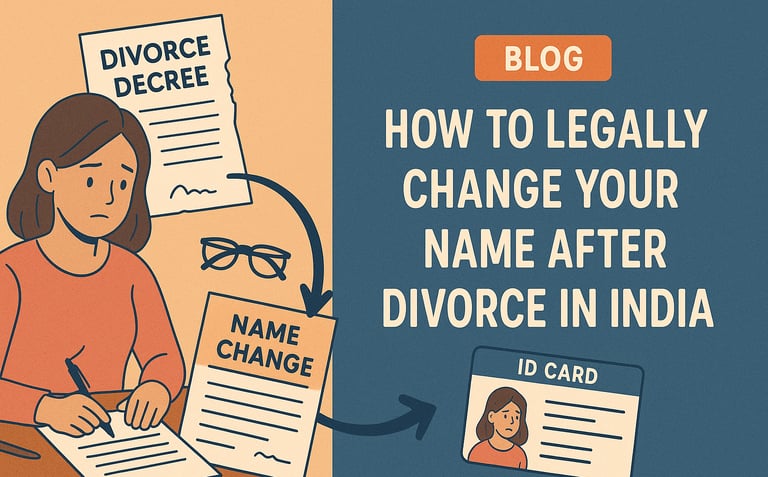How to Legally Change Your Name After Divorce in India
This article explains the legal steps, documents, and publication process for changing your name after divorce in India, ensuring legal compliance.
FAMILY LAW
khushi
7/24/20253 min read


When the marriage ends, a name often remains stitched into documents, identities, and memories. But the first step toward reclaiming yourself can be reclaiming your name.
Changing a name after marriage can be a cultural norm for many individuals in India, especially women. The decision to revert to a maiden name or adopt a new one entirely is deeply personal, a symbolic gesture of closure and a practical necessity. Fortunately, Indian law provides a clear process to change one’s name legally after divorce. This article will take you through the complete legal procedure to change your name post-divorce in India—step by step, if you are willing to let go of a painful chapter or if you want to embrace your own identity once again.
Reasons for Name Change After Divorce
There can be several reasons why many individuals, especially women, change their name after divorce:
● Emotional reasons: Sometimes people want to reclaim their identity.
● Social clarity: To prevent any connection with a former partner.
● Professional continuity: To revert to a maiden name that was used before marriage.
● Legal reasons: For better consistency in documents and to avoid confusion in official records.
A standardized procedure is provided by the Indian legal system to help individuals make this change lawfully, regardless of the reason.
Legal Framework for Name Change in India
Rather, a general name change procedure that applies to everyone governs the process. Documents needed are an affidavit for name change, newspaper publication, and gazette notification. These steps are accepted by all government authorities and institutions in India for the recognition of the new name.
Step-by-Step Procedure for Name Change After Divorce
Step 1: An affidavit needs to be prepared.
An affidavit should mention:
● Your current name (with your ex-spouse’s surname, if applicable).
● Your new proposed name.
● Reason for changing your name.
● Your details, such as address, age, and father’s name.
This affidavit must be:
● Printed on non-judicial stamp paper.
● Signed by the applicant.
● Attested by a notary or magistrate.
Step 2: Publication of Advertisement in Newspaper.
Publish your name in two newspapers to change your name.
● One in your local language newspaper.
● One in an English daily newspaper.
The ad should mention your old and new names, and there should be a statement that you’ve changed your name via affidavit legally.
Example: “I, Neha Sharma, residing at XYZ, have changed my name to Neha Verma after taking a divorce from Mr. Rajat Sharma, and hence from now onwards I will be known as Neha Verma for all purposes.”
Step 3: Apply for Gazette Notification
This is the most crucial step, as the Government Gazette Notification is going to change your name legally across India. Send an application to the Department of Publication in Delhi or the State Gazette office (as applicable), along with:
● Affidavit (notarised)
● Publications of newspaper (original or certified copies).
● A request letter.
● Passport-size photographs.
● Divorce certificate or decree (this is optional, but it is advised for clarity).
● Proof of identity and address (like a PAN or Aadhaar card).
Your name will become official as soon as it is published in the Gazette. It will take around 30 to 60 days.
Step 4: To change your name formally.
You should update your name in the following documents as soon as it is formally published in the gazette:
● The Aadhar card: you can visit an Aadhaar centre or apply online to change your Aadhaar card with a gazette notification.
● PAN Card: submit a name change request with NSDL and a gazette copy.
● Passport: Apply for reissuance of passport by citing name.
● Bank accounts, insurance, employment records, etc.
Note: While updating documents, always carry original and photocopies of the Gazette notification
Points to Remember
Your ex-spouse’s consent is not required to change your name after marriage.
Although it is not required, including a divorce decree or judgement can improve your application.
Changing a child's name may require consent and separate affidavits from the courts or both parents.
In conclusion, changing your name after divorce is very deep and symbolic towards healing and self-redefinition after separating from your partner. It involves a number of steps, but when these steps are followed properly, it gains structure and legal recognition. A name change following a divorce can be a seamless and empowering legal transition, with correct paperwork and legal structure.
